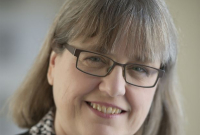Support strong Canadian climate journalism for 2025
A Canadian scientist who became only the third woman to win the Nobel Prize for Physics said her personal triumph doubles as a sign of progress for her male-dominated industry.
Donna Strickland, associate professor at Ontario's University of Waterloo, was honoured on Tuesday for being half of the team to discover Chirped Pulse Amplification, a technique that underpins today's short-pulse, high-intensity lasers.
The 59-year-old Guelph, Ont., native made the discovery while completing her PhD at the University of Rochester in New York and will share half of the US$1.01-million prize with her doctoral adviser, French physicist Gerard Mourou. The other half of the prize will go to Arthur Ashkin of the United States, who was the third winner of the award.
Strickland's victory not only cemented her own place in Nobel history, but ended a 55-year-long drought for female physicists being recognized by the prize committee. She joins the ranks of Marie Curie, the first woman to claim the honour in 1903, and 1963 winner Maria Goeppert-Mayer.
Strickland said reflecting on Goeppert-Mayer's career shows how far the scientific field has come in terms of gender parity despite the fact that women still make up only a quarter of attendees at major conferences.
Goeppert-Mayer, whose work was cited in Strickland's own award-winning efforts, went largely unpaid throughout her career.
"It's true that a woman hasn't been given the Nobel Prize since then, but I think things are better for women than they have been," Strickland told The Canadian Press in an interview. "We should never lose the fact that we are moving forward. We are always marching forward."
Strickland noted she has not personally experienced fundamental inequality and believes the field is ready to give women a more prominent place.
"I've always gotten paid equal to my colleagues and I feel I've been treated equally," she said. "I feel that women should start to get to be recognized more because for some reason not all men want to recognize us or not all people, but I think that's a minority. I think the majority of people are ready."
On Tuesday afternoon, Strickland received a standing ovation from faculty and students at the University of Waterloo during a news conference where, at one point, she told a young female scientist in the crowd to believe in herself.
"If somebody else thinks something that you don't believe in, just think they're wrong and you're right and keep going," Strickland said. "That's pretty much the way I always think."
Strickland's words moved Kristi Webb, a physics graduate student, to tears.
"I think she's a really great role model," said Webb, noting that Strickland won the Nobel prize for work done on her first published research paper. "This was at the very beginning of her career, but she's done a million things since then and that's the dream."
There were also lighter moments at Strickland's news conference, including when university president Feridun Hamdullahpur was asked whether Strickland's win was enough to vault her to the position of a full professor — he said there was a process for all to follow.
"I told her she doesn't have to submit a very long CV, one line will be sufficient," he said, drawing laughter from the crowd.
Sweden's Royal Academy of Sciences, which chose the winners, described Strickland and Mourou's work as "revolutionary."
The Chirped Pulse Amplification Technique, first laid out in a 1985 article, was described by the academy as "generating high-intensity, ultra-short optical pulses," which have become a critical part of corrective eye surgeries amongst other uses.
Strickland said she and Mourou were well aware that they were onto something in 1982 when they began researching ways to allow lasers to perform high-intensity, ultra-short pulses that would not damage the equipment.
When the pair refined the technique, Strickland recalled Mourou's advice to talk up their accomplishment and tell their peers that the gigawatt laser they had developed would lay the groundwork for devices a million times more powerful down the road.
"I knew he was right," she said. "It just seemed very bombastic for me to say it in front of the experts of the world."
Mourou's prediction came to pass a mere decade later, she said, adding Chirped Pulse Amplification now has broad applications.
The University of Waterloo called Strickland's win a "tremendous day" for the school and the campus was abuzz with the news.
Charmaine Dean, vice-president of research, said the university will be celebrating Strickland's win all year, but also emphasized that the prize means so much more than just an achievement for the professor and the school.
"This gives us a rallying point and a flag to hold high," Dean said with a broad smile. "This gives a beacon for further conversations about women in science and technology."
The sentiment was echoed by Prime Minister Justin Trudeau, who issued a statement congratulating Strickland on Tuesday evening and thanking her for "inspiring other women and young girls to dream without limits and pursue the careers of their choice."
Bob Lemieux, the school's dean of science, said he was "bouncing off the walls" with joy and added that faculty and administration members celebrated Strickland's prize Tuesday morning with champagne.
"I'm so damn proud of her," Lemieux said of Strickland. "It's a recognition of the strength of the physics and astronomy program and Donna in particular."
— with files from Michelle McQuigge and The Associated Press





Comments